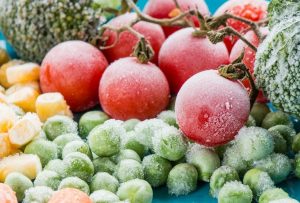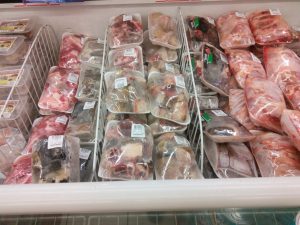Preservation by low temperature
- The use of low temperature to preserve food is based upon the fact that the actions of foodborne microorganism and enzyme response can be calmed down or ended at temperatures above freezing and generally stopped at subfreezing temperature.
- Low temperature can be generated by:-
- Refrigeration or chilling
- Freezing
- Refrigeration temperature generally in between 45°-32°F. Mostly below 38°F.
- Refrigeration or frigid storage of food is a reasonable method of food preservation. It has the least adverse consequence on the taste, texture and the nutritive value of food.
- Refrigeration is not the only means of preserving the food. refrigeration temperature is a crucial characteristic in indicating the duration of the storage period.
- As example meat will stay 6 to 10 days at0°C one day at 22°C and less than one day at 38°C.
- Most of the spoilage microorganisms selected warmer temperatures but there is a group of a microorganism called psychrophilic which will rise at refrigerator temperature.
- Basically refrigeration has no effect on a food taste or texture.
Why do we see more new refrigerated food entering the market place than other foods?
- Consumer demand for high quality foods:-
- beneficial -shorter cook times
- Purchasing habits
- Promoted processing techniques
- Aseptic processes
- Typically less change in the quality of food product

Chilling
- It’s a processing procedure in which the temperature of a food is decreased and maintained at a temperature between -1°C and 8°C.
- The purpose of cooling and chilling is to decrease the ratio of biochemical and microbiological differences in food in order to expand the shelf life of fresh and processed foods for to maintain a certain temperature in a food process.
- As an example in the fermentation and procedure of beer.
- In the wine industry cooling is applied to analyse the must before fermentation and the objective of cold stabilization is to obtain the condensation of the tartrate or fatty acids before bottling.
Advantages of chilling
- There is very limited change in flavour, colour, texture or shape.
- Nutrients are not destroyed.
- The buyer can be offered a much larger range of fresh and convenience food.

Freezing
- In food processing procedure of preserving food by reducing the temperature to inhibit microorganism development the method has been used for centuries in a cold region and a patent was issued in Britain at the year 1842 for frosting food by immersion in an ice and salt brine.
Principle of freezing
- Extreme cold stops the expansion of microorganism and restricts chemical changes such as enzymatic outcomes.
- freezing is the division system in which the temperature of food is decreased below its freezing point and proportion of the water undergoes a modification in the state to form frost crystals. The immobilization of water to ice and the arising concentration of dissolved solute in infusion water lowers the water activity of the food.
Advantages of freezing:-
- Frozen food can be maintained for a long period of time usually about three months.
- Simple methods. adds comfort to food preparation.
- Texture usually good than other techniques of food preservation.
Disadvantages of freezing:-
- The texture of some food is unsatisfactory because of the freezing process.
- Storage area restricted by the capability of the freezer.
Issues with frozen foods:-
- The chemical outcome can arise in frozen water.
- Some food blanched or sulfited before freezing.
- Fruits and vegetables loose Crispness.
- Undesirable biological changes.
Method of freezing:-
- The use of cold air blast or other low-temperature gases coming in connection with the food as for example tunnel, spiral, belt freezers.
- Indirect connection freezing as example plate freezes nicely packaged food or liquid is brought into the contact with metal surface cooled by circulating refrigerant.
Types of freezing:-
- Air freezing– product Frozen by either still or blast forced air.
- It is very inexpensive in investment.
- indirect contact:-food placed in direct contact with the cool metal surface which is relatively faster and more expensive.
- direct contact:-food placed in direct contact with refrigerant which is faster, expensive and freezes individual food particles.
- Some freezing equipment is mechanical freezer, cryogenic freezing, immersion freezing, plate freezing, rapid freezer, blast freezer.